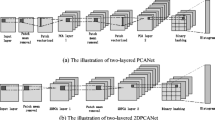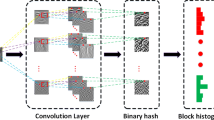Abstract
In this paper, we proposed an incremental two-dimensional kernel PCA-based convolutional network (I2DKPCN) which is a novel unsupervised deep learning network. In our architecture, I2DKPCN consists of several feature extraction stages and one output stage, and each feature extraction stage includes a convolutional layer, a feature pooling layer and a feature fusion layer. In the output stage, binary hashing and blockwise histograms are exploited for the generation of the final features. In particular, the filters of the convolutional layer are learned by using incremental two-dimensional kernel principal component analysis(I2DKPCA) rather than the gradient-based optimization. Due to the fact that the back propagation is not used to learn the parameters of the filter, the calculation speed of I2DKPCN is much faster than that of the existing deep network. We have extensively tested I2DKPCN on multiple data sets for three challenging tasks, including hand-written digit recognition, texture classification and face recognition. It can be seen from the results that I2DKPCN performs competitively or even better compared with other networks in all tests. Because the filters are learned by I2DKPCA, which combined the 2DPCA with kernel method and incremental learning, the non-linear problem was solved and the computational time was reduced.




Similar content being viewed by others
References
Fei L, Lu G, Jia W, Teng S, Zhang D (2018) Feature extraction methods for palmprint recognition: A survey and evaluation. IEEE Transactions on Systems, Man, and Cybernetics: Systems 49(2):346–363
Fei L, Zhang B, Jia W, Wen J, Zhang D (2020) Feature extraction for 3-d palmprint recognition: A survey. IEEE Trans Instrum Meas 69(3):645–656
Ma W, Wu Y, Cen F, Wang G (2020) Mdfn: Multi-scale deep feature learning network for object detection. Pattern Recogn 100:107149
Galzán E, Mooney P (2021) Neuroevolution in deep neural networks: Current trends and future challenges. IEEE Transactions on Artificial Intelligence
Zhou L, Min W, Lin D, Han Q, Liu R (2020) Detecting motion blurred vehicle logo in iov using filter-deblurgan and vl-yolo. IEEE Trans Veh Technol 69(4):3604–3614
Arunachalam A, Ravi V, Acharya V, Pham TD (2021) Toward data-model-agnostic autonomous machine-generated data labeling and annotation platform: Covid-19 autoannotation use case. IEEE Trans Eng Manag
Long B, Zhu Z, Yang W, Chong KT, Rodriguez J, Guerrero JM (2021) Gradient descent optimization based parameter identification for fcs-mpc control of lcl-type grid connected converter. IEEE Trans Ind Electron
deVos BD, Berendsen FF, Viergever MA, Sokooti H, Staring M, Išgum I (2019) A deep learning framework for unsupervised affine and deformable image registration. Medical image analysis 52:128–143
Caron M, Bojanowski P, Joulin A, Douze M (2018) Deep clustering for unsupervised learning of visual features. In: Proceedings of the European Conference on Computer Vision (ECCV), pp 132–149
Bi X, Li S, **ao B, Li Y, Wang G, Ma X (2020) Computer aided alzheimer’s disease diagnosis by an unsupervised deep learning technology. Neurocomputing 392:296–304
Wu Z, **ong Y, Yu SX, Lin D (2018) Unsupervised feature learning via non-parametric instance discrimination. In: Proceedings of the IEEE Conference on Computer Vision and Pattern Recognition, pp 3733–3742
Yu Y, Chan K HR, You C, Song C, Ma Y (2020) Learning diverse and discriminative representations via the principle of maximal coding rate reduction. Advances in Neural Information Processing Systems, 33
Mei S, Yang H, Yin Z (2018) An unsupervised-learning-based approach for automated defect inspection on textured surfaces. IEEE Trans Instrum Meas 67(6):1266–1277
Hussein S, Kandel P, Bolan CW, Wallace MB, Bagci U (2019) Lung and pancreatic tumor characterization in the deep learning era: novel supervised and unsupervised learning approaches. IEEE transactions on medical imaging 38(8):1777–1787
Hsu C-C, Lin C-W (2017) Cnn-based joint clustering and representation learning with feature drift compensation for large-scale image data. IEEE Transactions on Multimedia 20(2):421–429
Huang J, Dong Q, Gong S, Zhu X (2019) Unsupervised deep learning by neighbourhood discovery. In: International Conference on Machine Learning, PMLR, pp 2849–2858
**. IEEE Trans Knowl Data Eng 30(6):1065–1080
Kim D, Cho D, Kweon IS (2019) Self-supervised video representation learning with space-time cubic puzzles. In: Proceedings of the AAAI Conference on Artificial Intelligence, vol 33, pp 8545–8552
Xu P, Song Z, Yin Q, Song Y-Z, Wang L (2020) Deep self-supervised representation learning for free-hand sketch. IEEE Transactions on Circuits and Systems for Video Technology 31(4):1503–1513
Wang X, He K, Gupta A (2017) Transitive invariance for self-supervised visual representation learning. In: Proceedings of the IEEE international conference on computer vision, pp 1329–1338
Ansari AF, Scarlett J, Soh H (2020) A characteristic function approach to deep implicit generative modeling. In: Proceedings of the IEEE/CVF Conference on Computer Vision and Pattern Recognition, pp 7478–7487
Dornaika F (2021) Flexible data representation with feature convolution for semi-supervised learning. Appl Intell, pp 1–15
Shen Y, Qin J, Chen J, Yu M, Liu L, Zhu F, Shen F, Shao L (2020) Auto-encoding twin-bottleneck hashing. In: Proceedings of the IEEE/CVF Conference on Computer Vision and Pattern Recognition, pp 2818–2827
Tkach A, Tagliasacchi A, Remelli E, Pauly M, Fitzgibbon A (2017) Online generative model personalization for hand tracking. ACM Transactions on Graphics (ToG) 36(6):1–11
Ye M, Ji C, Chen H, Lei L, Lu H, Qian Y (2020) Residual deep pca-based feature extraction for hyperspectral image classification. Neural Comput & Applic 32(18):14287–14300
Zhang B, Qian J (2021) Autoencoder-based unsupervised clustering and hashing. Appl Intell 51(1):493–505
Chan T-H, Jia K, Gao S, Lu J, Zeng Z, Ma Y (2015) Pcanet: A simple deep learning baseline for image classification?. IEEE transactions on image processing 24(12):5017–5032
Yu H, Dai Q (2021) Dwe-il: a new incremental learning algorithm for non-stationary time series prediction via dynamically weighting ensemble learning. Appl Intell, pp 1–21
Wu J, Qiu S, Kong Y, Jiang L, Chen Y, Yang W, Senhadji L, Shu H (2018) Pcanet: An energy perspective. Neurocomputing 313:271–287
Gao Q, Ma L, Liu Y, Gao X, Nie F (2017) Angle 2dpca: A new formulation for 2dpca. IEEE transactions on cybernetics 48(5):1672–1678
**ao X, Zhou Y (2018) Two-dimensional quaternion pca and sparse pca. IEEE transactions on neural networks and learning systems 30(7):2028–2042
Sahoo TK, Banka H, Negi A (2020) Novel approaches to one-directional two-dimensional principal component analysis in hybrid pattern framework. Neural Comput & Applic 32(9):4897–4918
Yu D, Wu X-J (2018) 2dpcanet: a deep leaning network for face recognition. Multimedia Tools and Applications 77(10):12919–12934
Choi Y, Ozawa S, Lee M (2014) Incremental two-dimensional kernel principal component analysis. Neurocomputing 134:280–288
Bhattacharya S, Maddikunta P KR, Kaluri R, Singh S, Gadekallu TR, Alazab M, Tariq U, et al. (2020) A novel pca-firefly based xgboost classification model for intrusion detection in networks using gpu. Electronics 9(2):219
Yang X, Liu W, Tao D, Cheng J (2017) Canonical correlation analysis networks for two-view image recognition. Inf Sci 385:338–352
Mi J-X, Zhu Q, Lu J (2019) Principal component analysis based on block-norm minimization. Appl Intell 49(6):2169–2177
Jiang Q, Yan X (2018) Parallel pca–kpca for nonlinear process monitoring. Control Eng Pract 80:17–25
Li X, Wu H, Yang X, Xue P, Tan S (2021) Multiview machine vision research of fruits boxes handling robot based on the improved 2d kernel principal component analysis network. Journal of Robotics, 2021
Fujiwara T, Chou J-K, Shilpika S, Xu P, Ren L, Ma K-L (2019) An incremental dimensionality reduction method for visualizing streaming multidimensional data. IEEE transactions on visualization and computer graphics 26(1):418– 428
Charte D, Charte F, García S, del Jesus MJ, Herrera F (2018) A practical tutorial on autoencoders for nonlinear feature fusion: Taxonomy, models, software and guidelines. Information Fusion 44:78–96
Wang R, Thakur CS, Cohen G, Hamilton TJ, Tapson J, Schaik AV (2017) Neuromorphic hardware architecture using the neural engineering framework for pattern recognition. IEEE Trans Biomed Circuits Syst, pp 574–584
He K, Zhang X, Ren S, Sun J (2016) Deep residual learning for image recognition. In: Proceedings of the IEEE conference on computer vision and pattern recognition, pp 770–778
Ballester P, Araujo R (2016) On the performance of googlenet and alexnet applied to sketches. In: Proceedings of the AAAI Conference on Artificial Intelligence, vol 30
Zeng R, Wu J, Shao Z, Chen Y, Chen B, Senhadji L, Shu H (2016) Color image classification via quaternion principal component analysis network. Neurocomputing 216:416–428
Vishwakarma VP, Dalal S (2020) A novel non-linear modifier for adaptive illumination normalization for robust face recognition. Multimedia Tools and Applications 79(17):11503– 11529
Deng W, Hu J, Guo J (2017) Face recognition via collaborative representation: Its discriminant nature and superposed representation. IEEE transactions on pattern analysis and machine intelligence 40 (10):2513–2521
MacAllister A, Kohl A, Winer E (2020) Using high-fidelity meta-models to improve performance of small dataset trained bayesian networks. Expert Syst Appl 139:112830
Sudars K (2017) Face recognition face2vec based on deep learning: Small database case. Autom Control Comput Sci 51(1):50–54
Zhang Q, Zhang M, Chen T, Sun Z, Ma Y, Yu B (2019) Recent advances in convolutional neural network acceleration. Neurocomputing 323:37–51
Shao Z, Wu W, Wang Z, Du W, Li C (2018) Seaships: A large-scale precisely annotated dataset for ship detection. IEEE transactions on multimedia 20(10):2593–2604
Krizhevsky A, Sutskever I, Hinton GE (2017) Imagenet classification with deep convolutional neural networks. Commun ACM 60(6):84–90
Acknowledgements
This work was supported by Shanghai Agriculture Applied Technology Development Program, China (2020-02-08-00-07-F01480).
Author information
Authors and Affiliations
Corresponding author
Additional information
Publisher’s note
Springer Nature remains neutral with regard to jurisdictional claims in published maps and institutional affiliations.
This work was supported in part by Shanghai Agriculture Applied Technology Development Program, China (2020-02-08-00-07-F01480).
Rights and permissions
About this article
Cite this article
Zhao, R., Shi, F. I2DKPCN: an unsupervised deep learning network. Appl Intell 52, 9938–9951 (2022). https://doi.org/10.1007/s10489-021-03007-9
Accepted:
Published:
Issue Date:
DOI: https://doi.org/10.1007/s10489-021-03007-9




